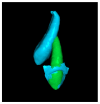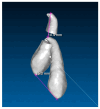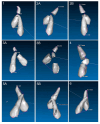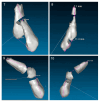Three-Dimensional Comparison of CBCT and Intraoral Scans for Assessing Orthodontic Traction of Impacted Canines with Clear Aligners
- PMID: 40710131
- PMCID: PMC12293305
- DOI: 10.3390/dj13070286
Three-Dimensional Comparison of CBCT and Intraoral Scans for Assessing Orthodontic Traction of Impacted Canines with Clear Aligners
Abstract
Background: Canine impaction complicates treatment and prolongs duration, requiring precise localization. CBCT is the gold standard for diagnosis and assessment. However, it involves high radiation exposure and cost. This study aimed to evaluate the effectiveness of a combined biomechanical approach for orthodontic traction of impacted maxillary canines (IMCs) and to determine whether intraoral scans (STL files) could replace a final CBCT in assessing canine repositioning. Methods: The sample included 10 patients (7 males and 3 females) with 13 severely displaced IMCs, treated with a protocol combining Invisalign® aligners, elastics, mini-implants, and sectional wires. In all, 9 IMC were palatally impacted, while 4 were buccally impacted. A representative clinical case is presented to illustrate the biomechanics used in one of the complex cases. Canine movement was evaluated at the cusp and apex through two methods: overlay of pre- and post-treatment CBCTs, and overlay of initial and final STL scans onto the initial CBCT. Results: A Class I canine relationship was successfully achieved in all patients. No statistically significant differences were found between the two measurement methods (p > 0.05). Conclusions: Orthodontic traction of IMC, especially in complex cases, can be achieved using aligners, elastics, mini-implants, and sectional wires. Once the canine crown has erupted and is clinically visible, STL scans overlaid with the initial CBCT can accurately assess the final position of the crown and root. This allows clinicians to avoid a second CBCT in selected cases, reducing patient radiation exposure while maintaining diagnostic accuracy.
Keywords: 3D imaging; clear aligners; cone-beam computed tomography; cuspid; impacted; tooth.
Conflict of interest statement
The authors declare no conflicts of interest.
Figures























Similar articles
-
[Maxillary impacted canines: Statistical modeling of traction duration and resorption].Orthod Fr. 2025 Jul 16;96(2):203-215. doi: 10.1684/orthodfr.2025.187. Orthod Fr. 2025. PMID: 40668882 French.
-
An AI-based tool for prosthetic crown segmentation serving automated intraoral scan-to-CBCT registration in challenging high artifact scenarios.J Prosthet Dent. 2025 Jul;134(1):191-198. doi: 10.1016/j.prosdent.2025.02.004. Epub 2025 Feb 26. J Prosthet Dent. 2025. PMID: 40016077
-
Open versus closed surgical exposure of canine teeth that are displaced in the roof of the mouth.Cochrane Database Syst Rev. 2017 Aug 21;8(8):CD006966. doi: 10.1002/14651858.CD006966.pub3. Cochrane Database Syst Rev. 2017. PMID: 28828758 Free PMC article.
-
Orthodontic treatment for prominent lower front teeth (Class III malocclusion) in children.Cochrane Database Syst Rev. 2024 Apr 10;4(4):CD003451. doi: 10.1002/14651858.CD003451.pub3. Cochrane Database Syst Rev. 2024. PMID: 38597341 Free PMC article.
-
Non-surgical adjunctive interventions for accelerating tooth movement in patients undergoing orthodontic treatment.Cochrane Database Syst Rev. 2023 Jun 20;6(6):CD010887. doi: 10.1002/14651858.CD010887.pub3. Cochrane Database Syst Rev. 2023. PMID: 37339352 Free PMC article.
References
LinkOut - more resources
Full Text Sources
Miscellaneous

